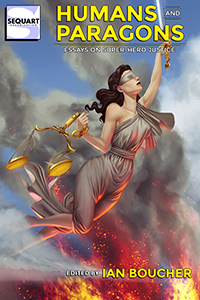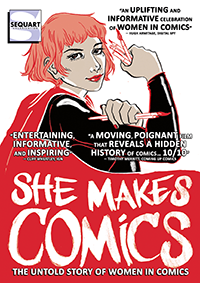Among with the flurry of new series announced at this year’s Image Expo was the news that Ed Brubaker and Sean Phillips (Criminal, Incognito, Fatale) had signed a five-year deal with the publisher that effectively gave them creative carte blanche. As Brubaker put it, “Sean [Phillips] and I are doing a five-year deal with Image where basically we can do whatever we want, and they have to publish it.” Along with that creative freedom for Brubaker and Phillips, the deal obviously demonstrates an enormous amount of trust on the part of Image. On one hand, this deal hints at a new model for creator-owned comics, but it also seems to be the logical extension of Image’s current modus operandi. If the announcements at Image Expo, the Brubaker / Phillips deal, and even their advertising strategy are any indication, it seems that the publisher has decided that creators, not content, drive sales.
The notion of creator-centric comics has obviously been a part of Image’s business model since its founding in 1992, and the founding partners clearly knew that their popularity with younger fans would help the success of their new venture (well, that along with the speculator-driven sales of the day). While the names Lee, Liefeld, and McFarlane attracted readers and collectors, there was still a primary focus on content since the publisher’s primary offerings (Spawn, Youngblood, Wildcats, etc.) were clearly intended to spin off into cartoons, toys, and the like. In that sense, Image operated much the same way that Marvel and DC did. The only difference was who owned, and profited from, the intellectual properties.
Ever since Eric Stephenson took over as publisher in 2008, there has been a noticeable shift in how Image sells both comics and itself as a brand. Instead of creating intellectual properties that could spin off into other media, there is a clear focus on the creators themselves. Obviously, The Walking Dead is an outlier here, but its success feels organic rather than orchestrated. The fact that Kirkman, Moore, and Adlard are prominently credited as creators of the show’s source material demonstrates the commitment to promoting creators. This focus is also evident in the publisher’s current marketing strategy, which features pictures of writers or artists instead of images from the actual comics. The implication here is that the audience is interested in reading a new title from Matt Fraction or Kelly Sue DeConnick regardless of its content. It’s a savvy marketing strategy, which, I think, largely works since most attentive comics fans do tend to follow creators more than characters.
In a sense, Image truly has changed the way comics are both made and marketed. By giving writers and artists freedom to create – and own – their work, Image has a clear interest in promoting said creators. The fact that new series are announced and marketed by the creators themselves demonstrates just how Image has helped foster a growing appreciation of those who are making comics. (This approach has spread to other publishers, too; notably Marvel, with books like Hawkeye, Daredevil, and Black Widow that showcase work far different from the publisher’s established “house style.” The critical success of those books seems to indicate we can expect a further Hawkeye-zation of mainstream titles.) By offering creators a forum for unlimited creativity, Image has clearly staked its success to the popularity of creators.
The Brubaker / Phillips deal is the logical next step to Image’s current approach since it places the focus squarely on the creators themselves. Image is hoping that the popularity and critical reputation of Brubaker and Phillips will be enough to sell titles, not just now, but over five years. Brubaker himself has stated that he will probably never do any long-running series like Kirkman has, but Image is banking that a few shorter runs will be just as successful. For their part, Brubaker and Phillips have a new type of creative freedom. Rather than pitching ideas to the publisher, they know that whatever they imagine will be published and, presumably, find an audience. Of course, the audience that will buy a title based solely on the Brubaker / Phillips credit exists largely thanks to Image’s own approach to creator-owned comics, as well as the hard work of Brubaker and Phillips to create engaging, interesting comics. This deal may be new territory for the business relationship between publishers and creators, but it’s the result of years of successfully changing how comics are made and marketed. Brubaker and Phillips have the track record to justify Image’s leap of faith, but it will be interesting to see how the next five years play out and if more creators strike this sort of deal with publishers.
While Image clearly intended that their deal with Brubaker and Phillips would be the biggest and most important announcement, there was a potentially larger story to emerge from Image Expo: diversity in comics. A number of critics took to Twitter last Thursday afternoon to point out the lack of people of color present, both in the audience and on stage, during the event (Bleeding Cool has collected the various responses here). Obviously, the lack of diversity among comics fans and creators is not an issue that is unique to Image, nor is it a problem with a single, simple solution. The lack of diversity on the creative side of comics has a direct impact on the audience, as Chew artist Rob Guillory pointed out via Twitter (edited for clarity):
So what’s the problem? Why do there seem to be more white fans AND creators than black? Is it some secret conspiracy to hold us down? Then I started teaching comic classes in poor black neighborhoods all around Louisiana. And what was the #1 reaction I had from those black kids I taught? “We can DO this? I thought comics were for white people.” I’m just saying. I think that the diversity issue in comics is bigger than “Whitey’s not letting blacks make comics obviously!” Clearly, I don’t have all the answers. I’m just saying what I’ve seen in my time in the industry. — Rob Guillory (@Rob_guillory) January 9, 2014
Again, this is not an issue unique to Image, but symptomatic of the larger comics culture. However, it would seem to be in the best interest of a publisher that has staked its reputation on being a haven for creators to encourage and foster a diverse group of talent. If creators are what sell books, as the publisher’s history and current business model seem to indicate, then there should be a more concerted effort to bring in new, unique voices to the creative process.
Right now, there are a few comics creators who can move books based on name alone. Image seems to think Brubaker and Phillips are such creators. (I think they are right, and I would probably add Kirkman, Grant Morrison, Matt Fraction, and Scott Snyder at least to that list.) However, how can new artists and writers find an audience if established names are what drive sales? The goal, it seems, is to find a way to combine creative freedom and the marketing power of an established publisher. The only way to do that is to foster and encourage new and distinct voices and talent. In order for comics to survive as a business and a medium, there needs to be a clear, loud message from publishers that a variety of unique creators are welcome and valued. Image has paved the way for recognizing and rewarding talented individuals. Here’s hoping that they, and other publishers, continue to do so in order to create a more diverse comics community.























































Just to be clear, while I definitely think having a more diverse character and creator base would help attract a more diverse audience, my point was more in pointing out an issue of under-exposure. From my experience, there are entire swathes of the youth that just aren’t even being exposed to comics as a medium. So, when I’d encounter black kids in my classes that had never read comics, their lack of gravitation to comics was less “there aren’t enough people that look like me to draw me in” and more “no one’s even exposed me to comics, let alone informed me this was an industry I could be a part of”.
Thanks for clarifying, Rob. Obviously this is a large issue with many causes not not one clear solution. I really think there is a reciprocal relationship between the audience and the creative community: a more diverse audience would create a more inclusive industry, and vice versa. I think the creator-centric approach to advertising is great for the creators themselves and people that are already fans, but the goal should be to attract new readers. The fact that both the attendees and the creators on stage at Image Expo were predominately white and male demonstrates the need for a larger comics audience. Again, there’s not one easy answer, but I’m glad the conversation about diversity is taking place.